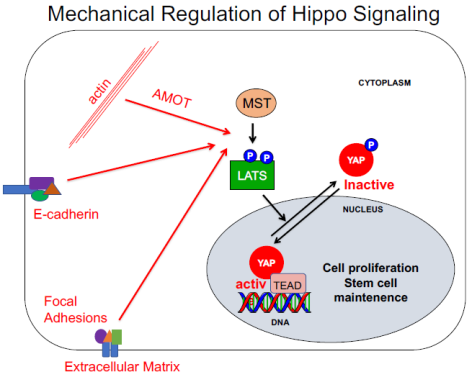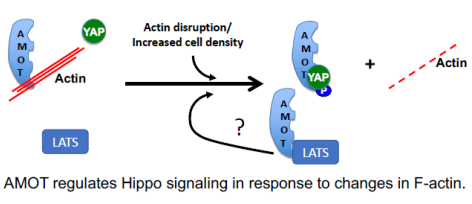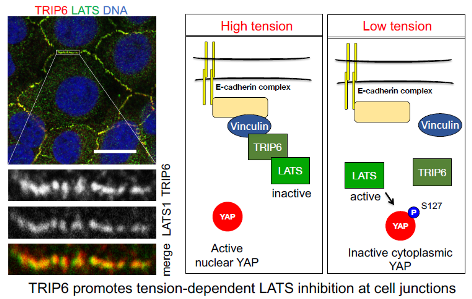Research
Regulation of Hippo signaling by mechanical stimuli.
 The Hippo pathway is known to monitor the mechanical environment both indirectly through the effects of various stimuli on the actin cytoskeleton, and more directly by sensing tension across tissues. My lab's focus has been on determining how F-actin levels and tension at cell-cell junctions are sensed, and how these signals are transduced to control Hippo signaling. We identified the angiomotin proteins as Hippo pathway sensors for F-actin levels and are currently studying how they control Hippo signaling. Our studies have also uncovered new Hippo pathway regulators at cell-cell junctions that may directly sense tension across tissues. Current research in the lab is focusing on understanding the molecular mechanisms underlying F-actin and tension sensing, and how signals from separate sensors are integrated to generate cellular responses to mechanical stimuli.
The Hippo pathway is known to monitor the mechanical environment both indirectly through the effects of various stimuli on the actin cytoskeleton, and more directly by sensing tension across tissues. My lab's focus has been on determining how F-actin levels and tension at cell-cell junctions are sensed, and how these signals are transduced to control Hippo signaling. We identified the angiomotin proteins as Hippo pathway sensors for F-actin levels and are currently studying how they control Hippo signaling. Our studies have also uncovered new Hippo pathway regulators at cell-cell junctions that may directly sense tension across tissues. Current research in the lab is focusing on understanding the molecular mechanisms underlying F-actin and tension sensing, and how signals from separate sensors are integrated to generate cellular responses to mechanical stimuli.
Angiomotins link Hippo signaling to the actin cytoskeleton.
 Cells rapidly remodel their actin cytoskeleton to deal with external forces and changes in their mechanical environment. Hippo signaling is strongly regulated by changes in actin organization. Thus one way that the Hippo pathway senses the mechanical environment appears to be through monitoring the actin cytoskeleton. How Hippo signaling senses and responds to changes in the actin cytoskeleton has remained uncertain. We identified angiomotins as novel Hippo pathway scaffolding proteins that are capable of interacting with both F-actin and multiple core components of the signaling network. Angiomotins inhibit YAP, a transcriptional co-activator that is the primary effector of Hippo signaling through two mechanisms; directly binding YAP and sequestering it in the cytoplasm, and by activating the YAP inhibitory kinase LATS. We showed that F-actin and YAP compete for binding to angiomotins rendering angiomotin inhibition of YAP sensitive to F-actin levels. These studies revealed one mechanism by which F-actin levels control Hippo signaling. Ongoing studies in the lab focus on how angiomotins activate LATS, whether this activation is regulated by F-actin, and whether other mechanisms operate to link Hippo signaling to F-actin organization.
Cells rapidly remodel their actin cytoskeleton to deal with external forces and changes in their mechanical environment. Hippo signaling is strongly regulated by changes in actin organization. Thus one way that the Hippo pathway senses the mechanical environment appears to be through monitoring the actin cytoskeleton. How Hippo signaling senses and responds to changes in the actin cytoskeleton has remained uncertain. We identified angiomotins as novel Hippo pathway scaffolding proteins that are capable of interacting with both F-actin and multiple core components of the signaling network. Angiomotins inhibit YAP, a transcriptional co-activator that is the primary effector of Hippo signaling through two mechanisms; directly binding YAP and sequestering it in the cytoplasm, and by activating the YAP inhibitory kinase LATS. We showed that F-actin and YAP compete for binding to angiomotins rendering angiomotin inhibition of YAP sensitive to F-actin levels. These studies revealed one mechanism by which F-actin levels control Hippo signaling. Ongoing studies in the lab focus on how angiomotins activate LATS, whether this activation is regulated by F-actin, and whether other mechanisms operate to link Hippo signaling to F-actin organization.
Regulation of Hippo signaling and cell proliferation by tension across tissues.
 Mechanical tension across tissues is a major regulator of cell proliferation, and plays an important role during development, organ growth, and tissue regeneration. Hippo pathway regulation of YAP is controlled by mechanical tension. When cells experience high mechanical tension, YAP localizes to the nucleus and promotes cell proliferation. Conversely, low tension causes YAP to exit the nucleus and cells to arrest growth. Transmission of tension across tissues requires cell-cell adhesion such as that provided by cadherins. We showed that tension sensed at cell-cell junctions triggers activation of a LATS inhibitor TRIP6 that recruits LATS to cell-cell junctions and inhibits it. Current studies are focused on understanding the molecular mechanism by which tension sensing controls LATS activity and identifying additional components of the tension sensing system.
Mechanical tension across tissues is a major regulator of cell proliferation, and plays an important role during development, organ growth, and tissue regeneration. Hippo pathway regulation of YAP is controlled by mechanical tension. When cells experience high mechanical tension, YAP localizes to the nucleus and promotes cell proliferation. Conversely, low tension causes YAP to exit the nucleus and cells to arrest growth. Transmission of tension across tissues requires cell-cell adhesion such as that provided by cadherins. We showed that tension sensed at cell-cell junctions triggers activation of a LATS inhibitor TRIP6 that recruits LATS to cell-cell junctions and inhibits it. Current studies are focused on understanding the molecular mechanism by which tension sensing controls LATS activity and identifying additional components of the tension sensing system.

